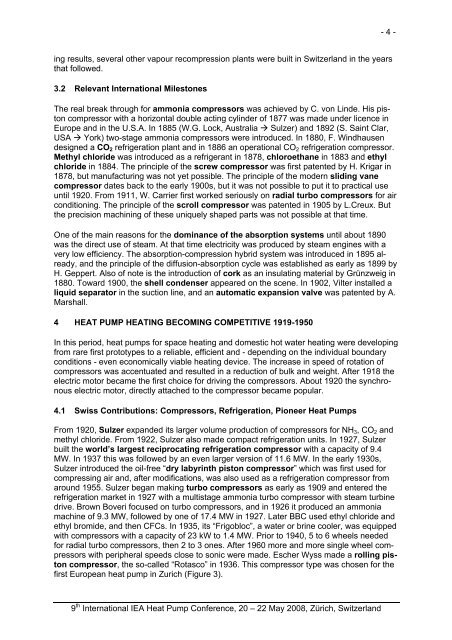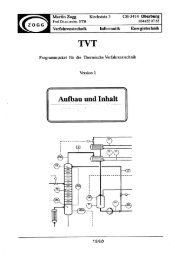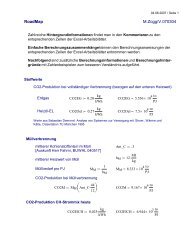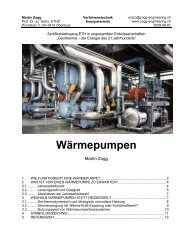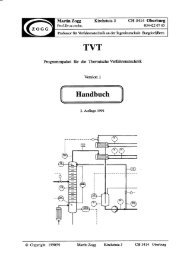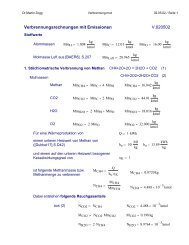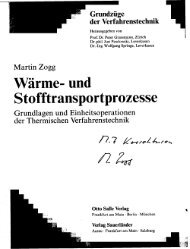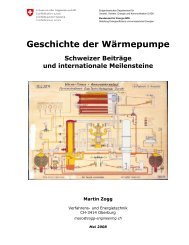TITLE, PLEASE USE 14-pt ARIAL FONT, BOLD ... - of Martin Zogg
TITLE, PLEASE USE 14-pt ARIAL FONT, BOLD ... - of Martin Zogg
TITLE, PLEASE USE 14-pt ARIAL FONT, BOLD ... - of Martin Zogg
You also want an ePaper? Increase the reach of your titles
YUMPU automatically turns print PDFs into web optimized ePapers that Google loves.
ing results, several other vapour recompression plants were built in Switzerland in the years<br />
that followed.<br />
3.2 Relevant International Milestones<br />
- 4 -<br />
The real break through for ammonia compressors was achieved by C. von Linde. His piston<br />
compressor with a horizontal double acting cylinder <strong>of</strong> 1877 was made under licence in<br />
Europe and in the U.S.A. In 1885 (W.G. Lock, Australia � Sulzer) and 1892 (S. Saint Clar,<br />
USA � York) two-stage ammonia compressors were introduced. In 1880, F. Windhausen<br />
designed a CO2 refrigeration plant and in 1886 an operational CO2 refrigeration compressor.<br />
Methyl chloride was introduced as a refrigerant in 1878, chloroethane in 1883 and ethyl<br />
chloride in 1884. The principle <strong>of</strong> the screw compressor was first patented by H. Krigar in<br />
1878, but manufacturing was not yet possible. The principle <strong>of</strong> the modern sliding vane<br />
compressor dates back to the early 1900s, but it was not possible to put it to practical use<br />
until 1920. From 1911, W. Carrier first worked seriously on radial turbo compressors for air<br />
conditioning. The principle <strong>of</strong> the scroll compressor was patented in 1905 by L.Creux. But<br />
the precision machining <strong>of</strong> these uniquely shaped parts was not possible at that time.<br />
One <strong>of</strong> the main reasons for the dominance <strong>of</strong> the absor<strong>pt</strong>ion systems until about 1890<br />
was the direct use <strong>of</strong> steam. At that time electricity was produced by steam engines with a<br />
very low efficiency. The absor<strong>pt</strong>ion-compression hybrid system was introduced in 1895 already,<br />
and the principle <strong>of</strong> the diffusion-absor<strong>pt</strong>ion cycle was established as early as 1899 by<br />
H. Geppert. Also <strong>of</strong> note is the introduction <strong>of</strong> cork as an insulating material by Grünzweig in<br />
1880. Toward 1900, the shell condenser appeared on the scene. In 1902, Vilter installed a<br />
liquid separator in the suction line, and an automatic expansion valve was patented by A.<br />
Marshall.<br />
4 HEAT PUMP HEATING BECOMING COMPETITIVE 1919-1950<br />
In this period, heat pumps for space heating and domestic hot water heating were developing<br />
from rare first prototypes to a reliable, efficient and - depending on the individual boundary<br />
conditions - even economically viable heating device. The increase in speed <strong>of</strong> rotation <strong>of</strong><br />
compressors was accentuated and resulted in a reduction <strong>of</strong> bulk and weight. After 1918 the<br />
electric motor became the first choice for driving the compressors. About 1920 the synchronous<br />
electric motor, directly attached to the compressor became popular.<br />
4.1 Swiss Contributions: Compressors, Refrigeration, Pioneer Heat Pumps<br />
From 1920, Sulzer expanded its larger volume production <strong>of</strong> compressors for NH3, CO2 and<br />
methyl chloride. From 1922, Sulzer also made compact refrigeration units. In 1927, Sulzer<br />
built the world’s largest reciprocating refrigeration compressor with a capacity <strong>of</strong> 9.4<br />
MW. In 1937 this was followed by an even larger version <strong>of</strong> 11.6 MW. In the early 1930s,<br />
Sulzer introduced the oil-free “dry labyrinth piston compressor” which was first used for<br />
compressing air and, after modifications, was also used as a refrigeration compressor from<br />
around 1955. Sulzer began making turbo compressors as early as 1909 and entered the<br />
refrigeration market in 1927 with a multistage ammonia turbo compressor with steam turbine<br />
drive. Brown Boveri focused on turbo compressors, and in 1926 it produced an ammonia<br />
machine <strong>of</strong> 9.3 MW, followed by one <strong>of</strong> 17.4 MW in 1927. Later BBC used ethyl chloride and<br />
ethyl bromide, and then CFCs. In 1935, its “Frigobloc”, a water or brine cooler, was equipped<br />
with compressors with a capacity <strong>of</strong> 23 kW to 1.4 MW. Prior to 1940, 5 to 6 wheels needed<br />
for radial turbo compressors, then 2 to 3 ones. After 1960 more and more single wheel compressors<br />
with peripheral speeds close to sonic were made. Escher Wyss made a rolling piston<br />
compressor, the so-called “Rotasco” in 1936. This compressor type was chosen for the<br />
first European heat pump in Zurich (Figure 3).<br />
9 th International IEA Heat Pump Conference, 20 – 22 May 2008, Zürich, Switzerland


